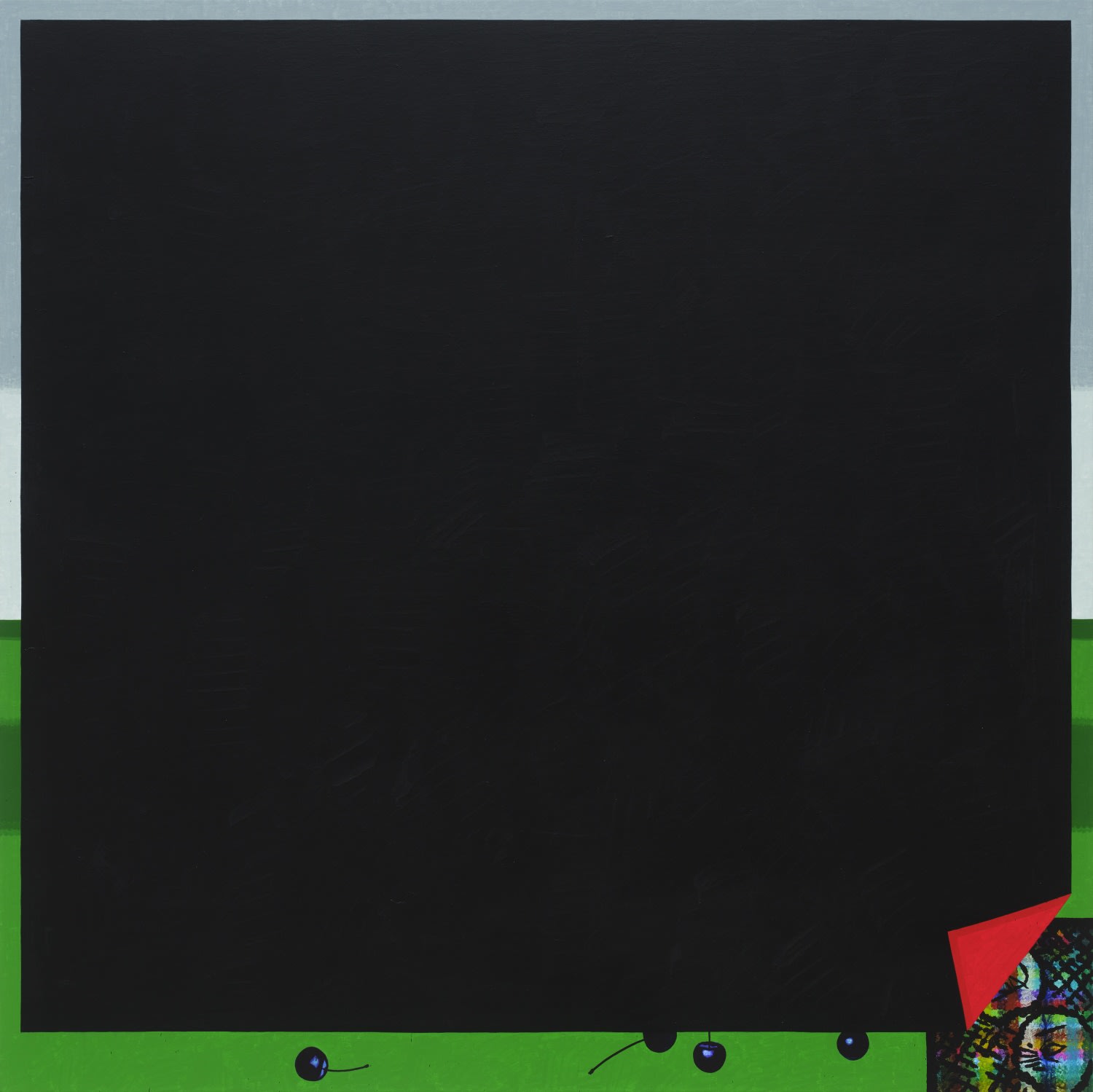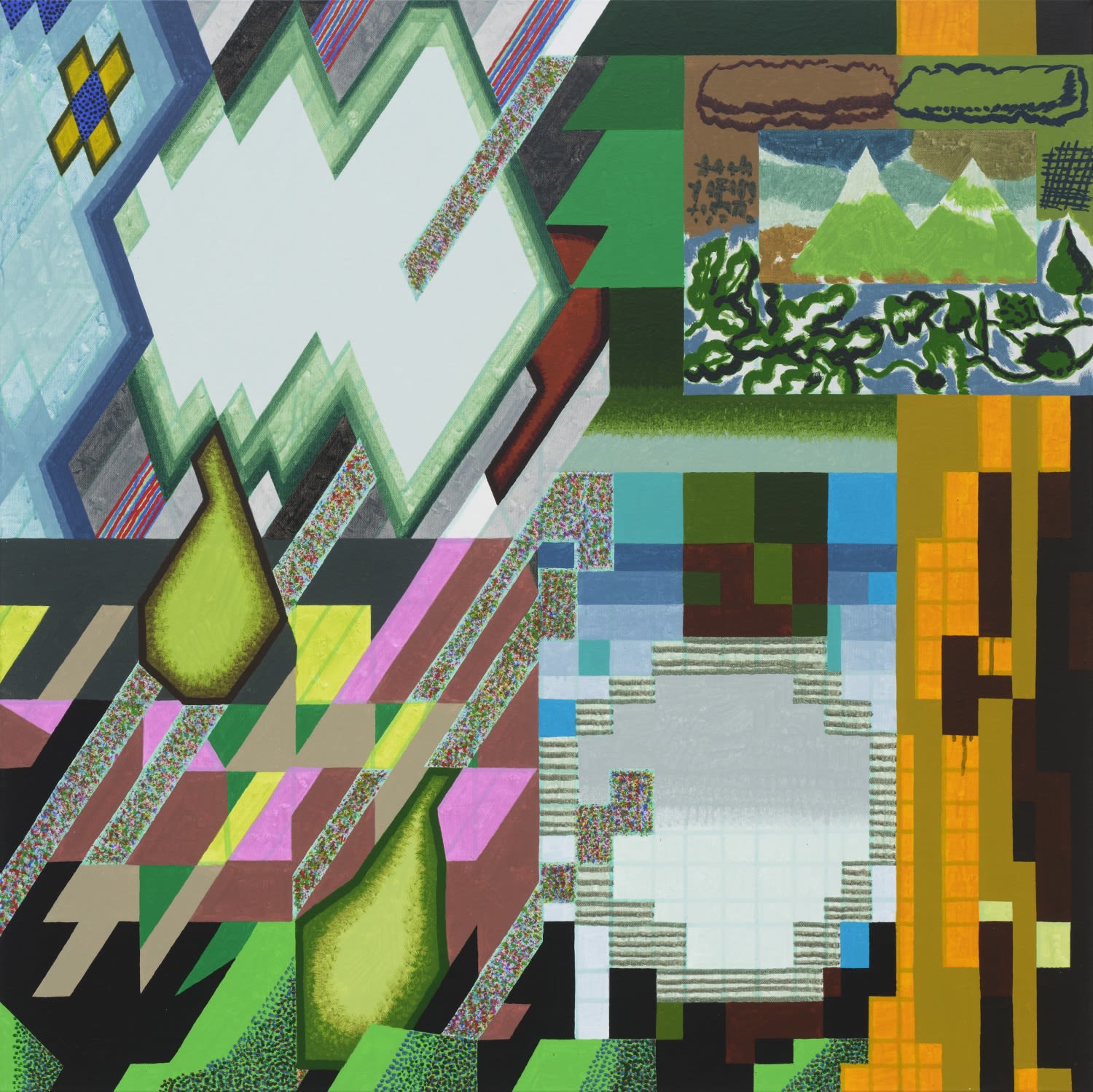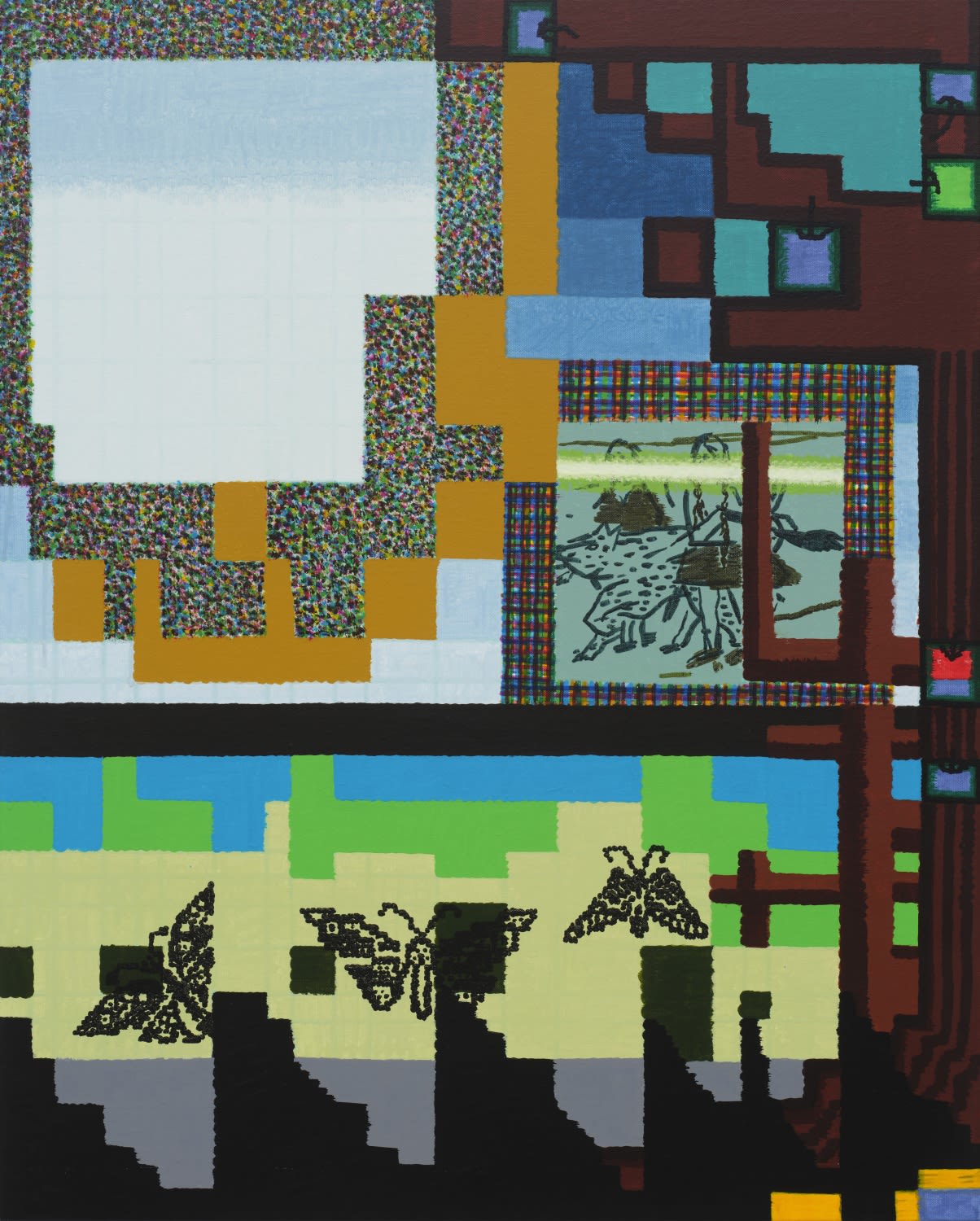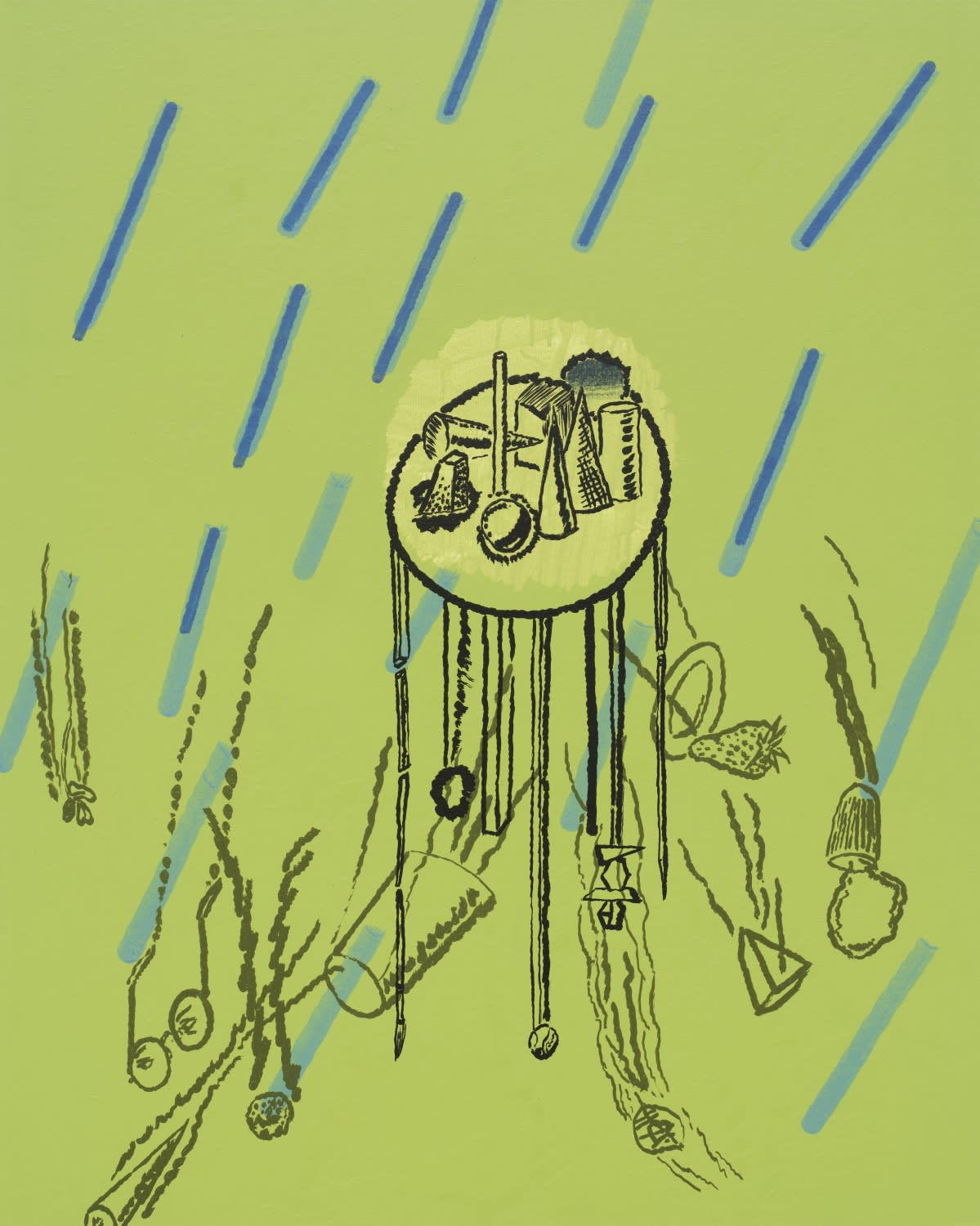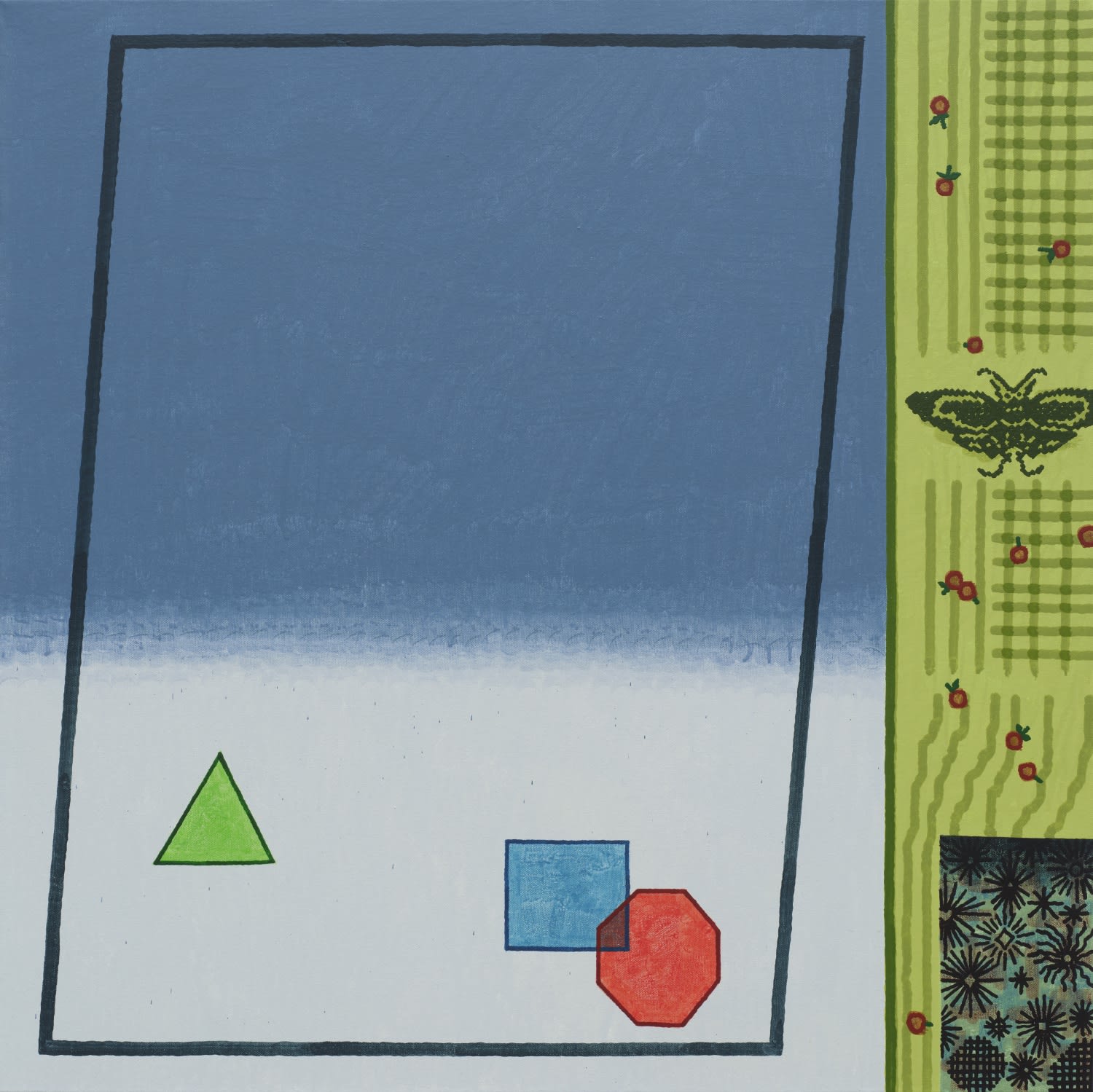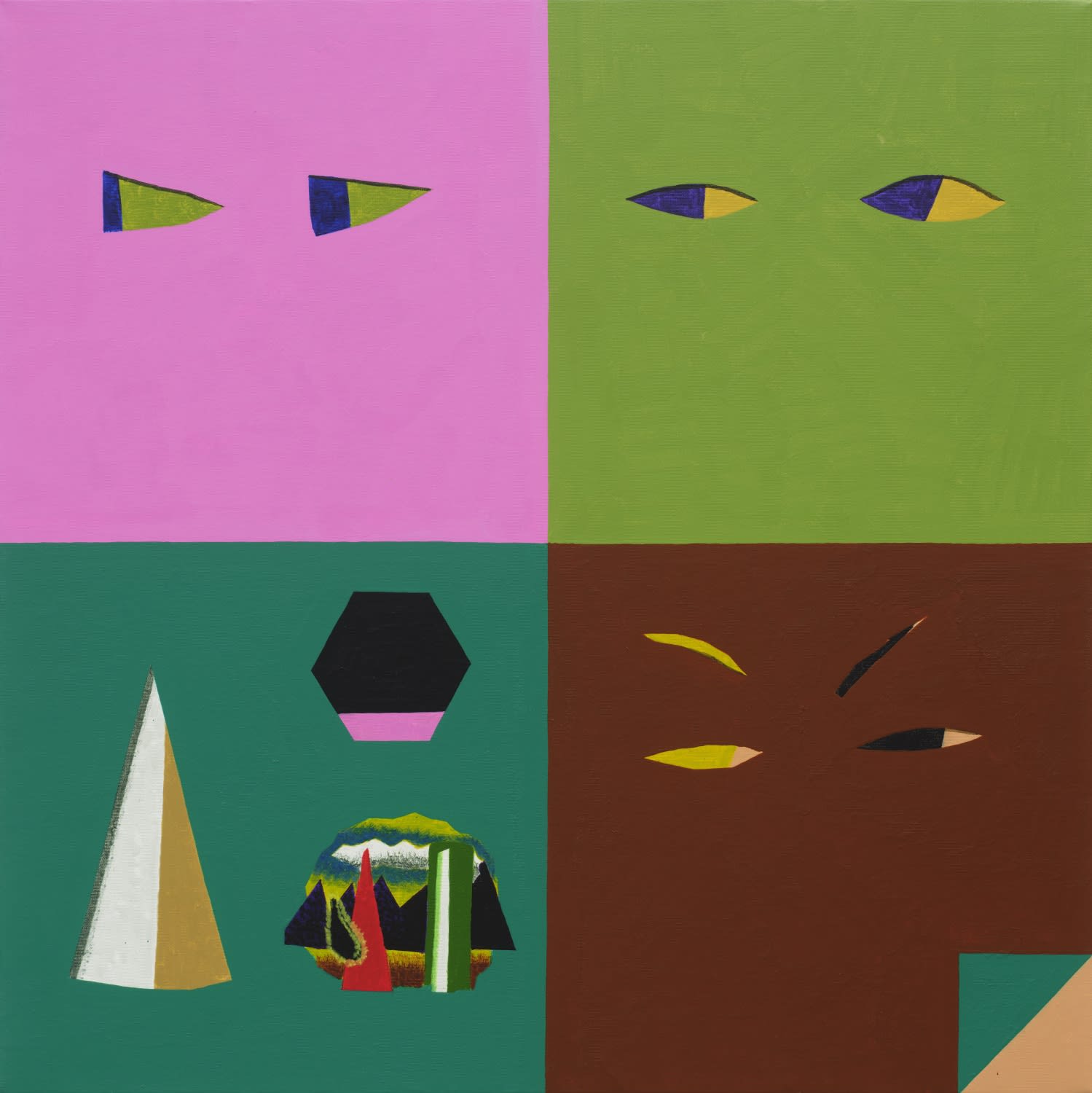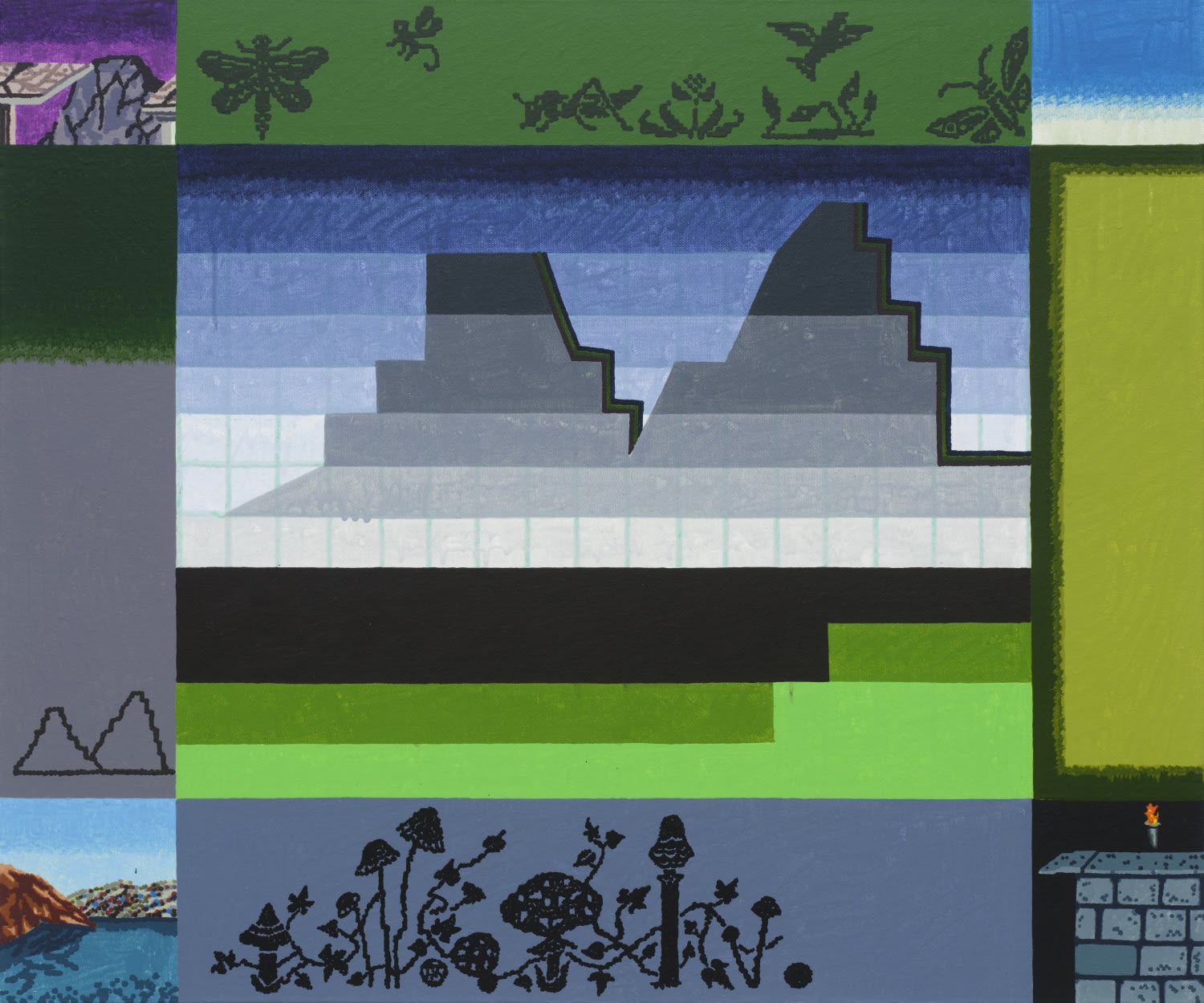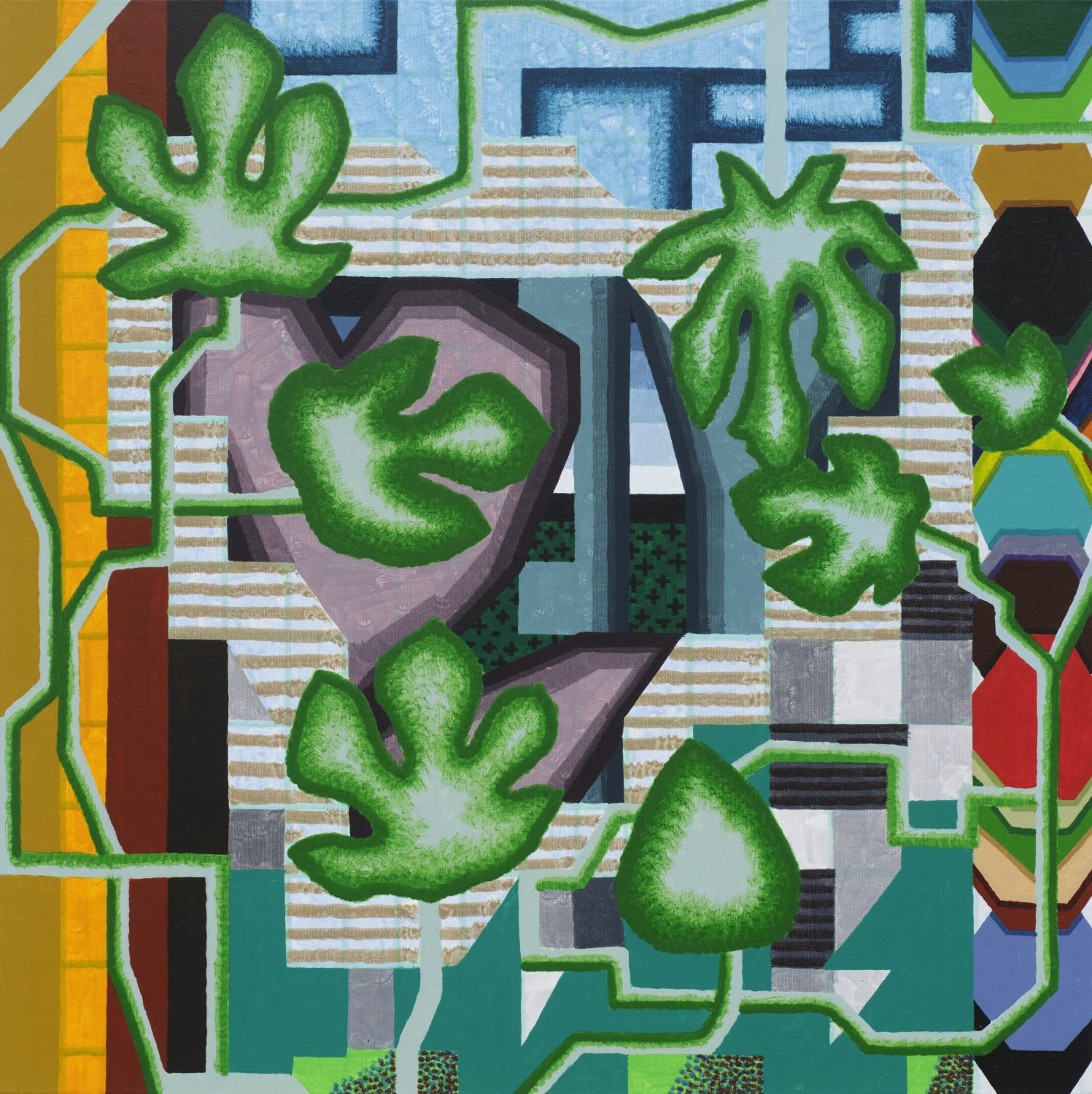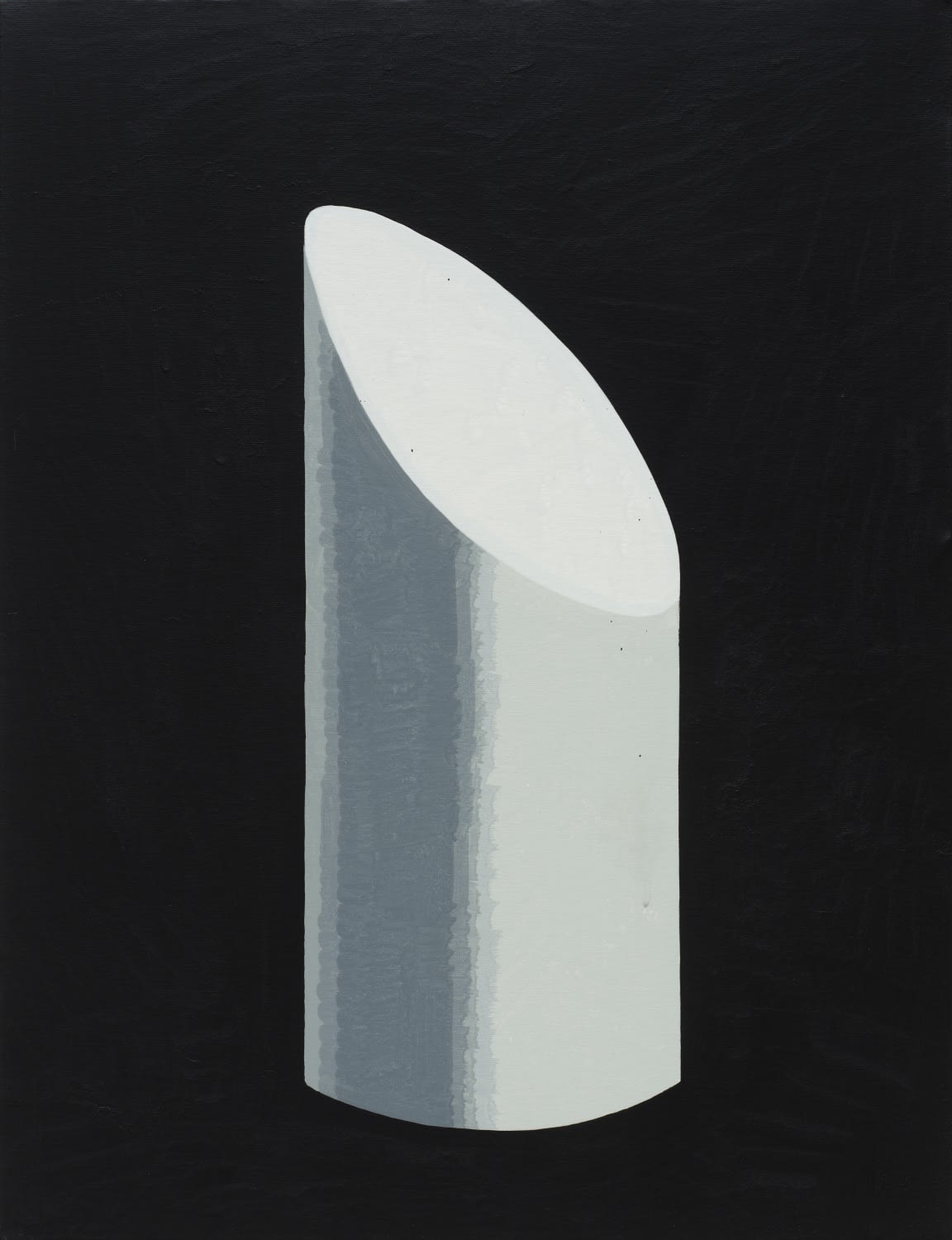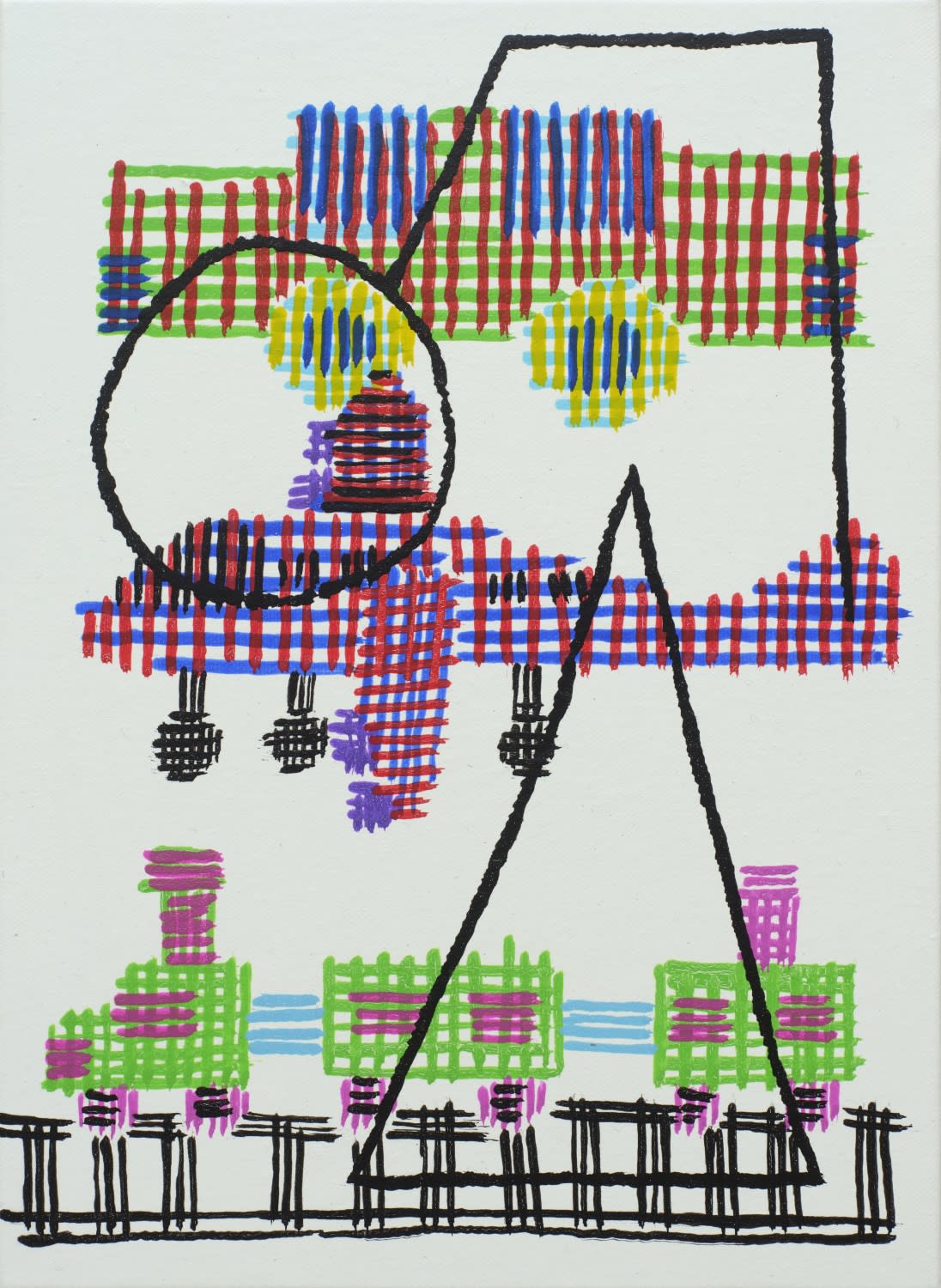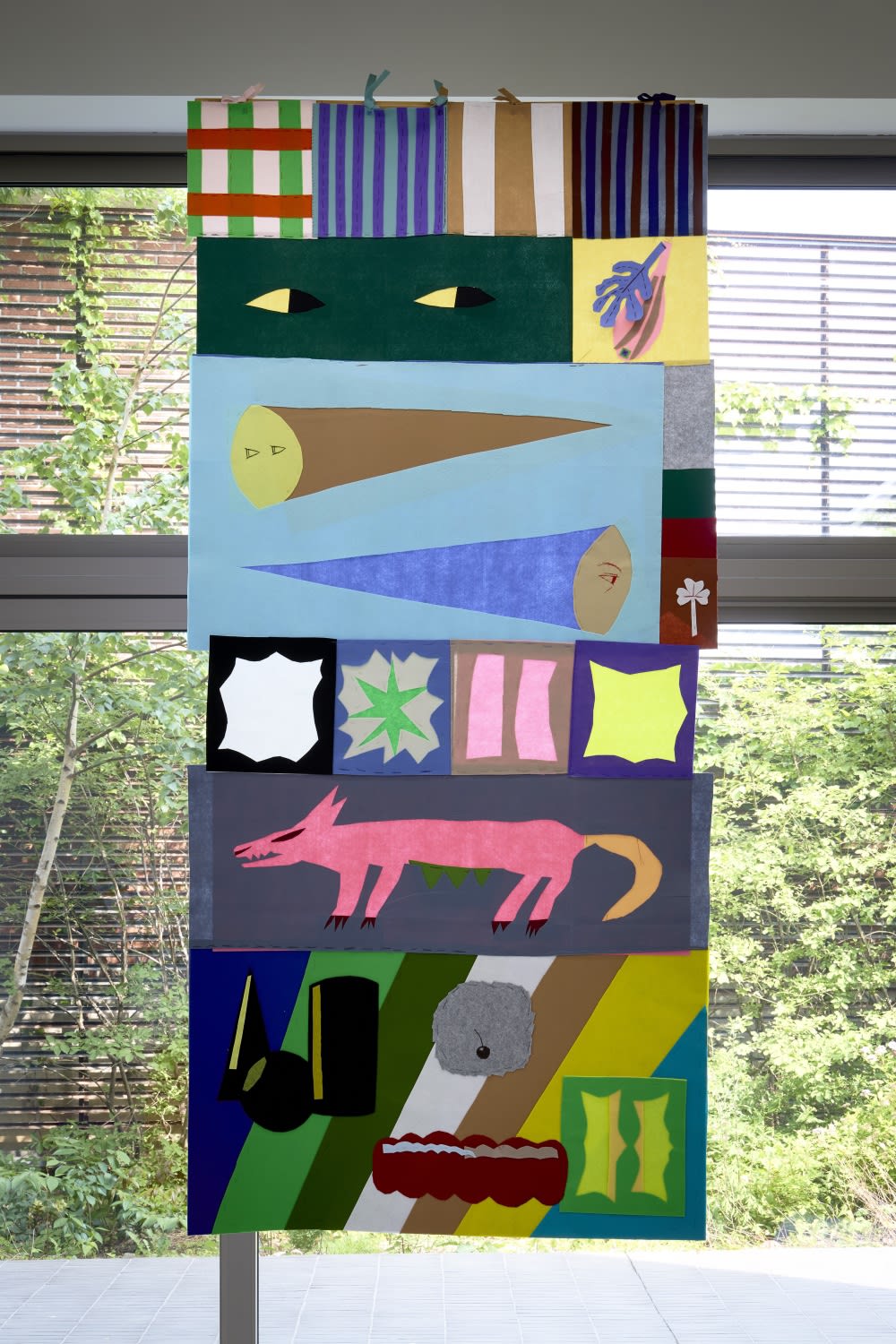눈꺼풀은 세계와 나를 가르는 막이다. 그러나 그것은 결코 한 겹이 아니라고 말할 수 있다면, 그 믿음은 우리를 어디로 향하게 할까? 우리는 눈을 뜨고 있으면서도 무언가 보지 못하고, 눈을 감고 있으면서도 그 너머의 어떤 장면을 기억하거나 상상한다. 《우리의 눈꺼풀은 한 겹이 아니다》는 그러한 복수의 시선, 겹치고 분절된 시간에 관한 이야기다. 서로 다른 이미지와 방식들이 맞닿고, 혼재되고, 간섭하며 결국 하나의 화면으로 수렴되는 과정에서, 부분들의 명징함에 반해 끝내 모호해지는 전체의 이미지는 곧 세계를 방황하며 맴도는 우리를 비춘다.
이번 전시는 삶과 세계, 회화의 표면을 다층적으로 사유하려는 시도다. 전현선의 회화는 단적이고 확정된 의미를 전달하기보다는, 다중 세계처럼 가능한 의미의 겹을 펼쳐 보인다. 눈꺼풀이 한 겹이 아니라는 상상처럼, 한 종류의 흐름으로 정리되지 않는 삶과 이 세계의 이야기가 그의 회화에 담긴다. 전현선은 주로 인물, 도형, 사물, 패턴 등 다양한 이미지를 한 화면에 병치해 왔다. 그렇게 넓은 면에 걸쳐 편재된 이미지들은 저마다의 운동감을 찾아가며 서로 충돌하는 동시에 충돌하지 않으면서 공존할 방안을 탐색한다. 일종의 ‘전체로서 평면’에 머무르기 위해 ‘부분으로서 평면들’의 조우와 부딪힘이 화면 위에서 연속적으로 일어나는 것이다. 이러한 사유는 그가 어린 시절부터 접해 온 시각 환경 속에 배어든 평면성의 감각에서 비롯한다. 일례로 2D와 3D 사이에 머물렀던 2000년대 초반의 그래픽 이미지와 학종이, 양면 색종이, 십자수, 캔버스가 지닌 수직・수평의 구조, 납작한 모양에 가까운 입체감 같은 것들로부터 기인한 경험은 이미지 간의 차이보다는 이들이 얽히고설켜 함께하는 현상 그 자체에 주목하게 한다.
그에게 ‘그리기’는 하나의 세계 너머에 놓인 또 다른 가능성을 상상하는 일에서 출발한다. 우리는 매 순간 선택하며 살아가지만, 선택하지 않은 삶 또한 어딘가에서 다른 나로 분기되고 있을지도 모른다. 이는 단지 흥미로운 망상이 아니라, 지금 이 시간을 맹목적 확신 없이도 살아갈 수 있게 해주는 대안적 위안이며, 지금 여기와 다른 어딘가를 끊임없이 넘보게 하는 동력이다. 그가 그리는 회화들은 각기 다른 방식으로 경계를 분절하고 확장해 나간다. 예컨대, 패턴과 픽셀 구조가 교차하는 회화 속 대상들은 모두가 중심이 아닌 주변부에서 장면을 조직하는 기호로 등장한다. 망원경처럼 긴 원통은 작가 자신의 자화상인 동시에 이미지 너머를 응시하는 시선으로 읽히며, 캔버스, 유리창, 프레임은 창밖의 세계를 호출하는 환영으로 기능한다. 또, 회화의 물리적 구조를 반영한 그리드 기반의 형상은 직조나 수공의 메커니즘, 디지털 인터페이스의 잔상을 불러들이며, 전현선이 구축하는 이미지가 개인의 기억, 손의 움직임, 그리고 시선의 거리에 관한 인식에 의해 형성됨을 환기한다.
이러한 감각은 그가 회화에 지닌 태도를 공간적 차원으로 이어가는 과정에서도 드러난다. 그림에서 떨어져 나와 전시장 곳곳에 설치된 기둥 모양 패브릭은 눈을 뜨고 있는 얼굴, 감은 얼굴 등 다양한 표정을 지으며 관객과 마주선다. 작가가 손바느질로 직접 만든 인형들은 평평해진 화면 속 이미지가 물성을 지닌 객체로 구체화된 존재들이다. 이는 그가 지금까지 켜켜이 쌓아 온 이미지의 평면적 성질을 확장하여 삶과 세계의 영역을 가로지르는 흐름을 현시하는 구현물로 기능한다. 한편, 원기둥이나 원뿔, 육면체 등 기초적인 도형을 그린 회화는 이러한 자신의 실천이 회화로 귀결되는 근원적인 이유, 그가 회화를 지속하는 태도를 은유한다. 동시에 동일한 구조와 형상이 여러 회화에서 조금씩 다른 방식으로 반복되거나 각기 다른 기법들이 상호적으로 놓이면서, 회화들은 서로를 반사하고 호응하는 감각을 만들어 낸다. 탐구를 이어갈수록 어딘가로 빠져나가지 않고 사이들을 맴도는 행위로서, 눈꺼풀이 하나가 아니라는, 어쩌면 허무한 그 믿음이 이 모든 사유의 출발점이 된다.
전현선의 이야기는 확정된 진술이나 결론을 내리려 하지 않는다. 그보다는 결말이 되기를 밀어내는 소서사들, 열린 레이어들, 겹침과 분절의 공존에 대해 말한다. 우리는 한 화면 앞에 서 있지만, 그 안에서 여러 갈래의 세계를 동시에 마주한다. 삶은 하나의 직선이 아니라, 계속해서 갈라지고 되돌아오며 스스로를 반복하는 순환인지도 모른다. 눈꺼풀처럼 얇고 투명한 세계의 경계 위에서 우리는 끝없이 물으며 배회한다. 우리가 보는 것은 정말 하나인가? 그리고 그 하나는 정말, 전부인가?
The eyelid is a membrane is a threshold between the world and the self, serving to mediate rather than separate. If our eyelids are more than a bifurcating layer, where does that thought lead us? We overlook what lies before us, even with eyes wide open. When we close our eyes, we conjure, recall, or imagine scenes beyond our immediate sight. Our Eyelids Are More Than a Layer orbits these multifaceted modes of seeing and explores time as it overlaps, refracts, and fragments.
As disparate images and methods brush against and entangle one another in Jeon Hyunsun’s works, they eventually converge within a single visual field. That is, even as its parts remain sharply defined, the resulting image remains ambiguous in its entirety. This ambiguity mirrors our own circling and drifting passage through the world.
The exhibition unfolds as a layered meditation on life, the world, and the surface of painting. Instead of delivering fixed or categorical meanings, Jeon Hyunsun’s paintings unfold multilayered possibilities, much like parallel universes. Just as the notion that eyelids are more than a layer suggests, her canvases resist being flattened into a single narrative or flow. They ripple and fuzz with stories that diverge, overlap, and defy any singular scheme.
Jeon habitually juxtaposes figures, geometric forms, objects, and patterns across broad expanses of the picture plane. These images, dispersed across the surface, pulse with their own motion and seek ways to coexist. Sometimes they collide, sometimes they slip past one another, but always they negotiate space. Planes-as-parts continuously encounter and jostle across the visual field. This dynamic sustains a sense of wholeness that is always in flux.
Her approach springs from a lifelong acuity, awareness, and appreciation of flatness, a visual instinct shaped by the layered, hybrid environments of her childhood. Early-2000s graphics poised between 2D and 3D, origami paper, double-sided colored paper, cross-stitch, the vertical and horizontal scaffolding of canvas, and the paradox of three-dimensionality approaching flatness all inform her sensibility.
For Jeon, painting begins by probing what lies beyond a discrete and singular world and by imagining other possibilities just out of sight. We live on a timeline shaped through the continuum of our choices, but other lives—those of alternate choices—branch and spiral elsewhere as alternate selves. A perennially popular cinematic plot device, it is also a sustaining counterpoint to blind certainty, a consolation that lets us inhabit the present, and a force that draws us toward other horizons.
Her paintings cleave and extend boundaries in ever-shifting, fluid ways. Within works where patterns and pixel structures intersect, all objects emerge as signs that compose the scene from the margins rather than the center. Long cylinders, reminiscent of monocular telescopes, double as self-portraits and as gazes cast beyond the image. Canvases, panes of glass, and frames become phantom portals that summon worlds outside the window. Grid-based forms, echoing the physical structure of painting, evoke the mechanics of weaving, the tactility of craft, and the ghostly afterimage of digital interfaces. All of these elements remind us that Jeon’s images are shaped by memory, the movement of hands, and the shifting distance of the gaze.
This layered sensibility radiates outward and animates the spatial dimension of Jeon Hyunsun’s exhibitions. Fabric-covered columnar forms, separate from the paintings and scattered throughout the exhibition space, greet visitors with a range of expressions. Faces with eyes—open or lcosed—are caught mid-blink. The artist’s conjured troup of hand-sewn dolls materialize flattened images as tactile presences. These objects embody the flow that traverses and links the realms of life and art, extending the planar logic of the paintings into lived space. Meanwhile, paintings of cylinders, cones, and cubes metaphorically ground her practice and offer glimpses into why she continually returns to painting.
Jeon’s works feature recurring forms and structures. Each time, they are refracted through subtly different approaches or juxtaposed with varied techniques. The works begin to mirror and correspond, generating a sense of resonance and reflection. And as this mutual inquiry deepens, the further it is to escape and closer it is to the orbit of in-between spaces. The belief that our eyelids are not singular, however fragile or uncertain, becomes the very point of departure for all this contemplation.
Jeon’s narrative resists definitive statements or conclusions. Instead, it dwells in minor narratives that refuse to resolve, in open layers, and in the coexistence of overlap and fragmentation. We stand before a single visual field, yet within it, we encounter multiple branching worlds at once. Life may not be a single straight line but a circuit, constantly branching, returning, and repeating itself. On the thin, translucent boundary of the world, like the membrane of an eyelid, we wander and question endlessly. Is what we see ever truly singular? And if so, is that singularity ever the whole?

